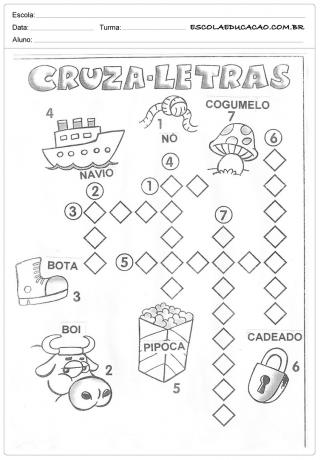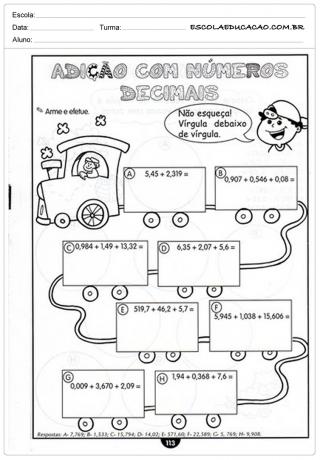Check out the questions that the Escola Educação team separated for you about Modern Art Week, an important event that provided a cultural break in Brazilian art.
Occurred in the city of Sao Paulo, it had the participation of several artists from the most varied areas.
Questions about the 1922 Modern Art Week
1 — Until the beginning of the 1920s, Brazil had a conservative and academic culture. In this sense, the Week of Modern Art had as its main objective:
a) To spread a new and modern expression of Brazilian art.
b) To spread an ancient and classic expression of Brazilian art.
c) Spreading a rebellious and innovative expression of Brazilian art.
d) To spread an ancient and contemporary expression of Brazilian art.
2 — During the 13th, 15th and 17th of February 1922, the city of São Paulo was the setting for this artistic meeting which had the participation of:
a) Writers, actors, architects, sculptors and painters.
b) Writers, intellectuals, architects, sculptors and musicians.
c) Writers, intellectuals, actors, musicians and painters.
d) Writers, intellectuals, architects, sculptors and painters.
3 — What was the location in the capital of São Paulo that hosted the Week of Modern Art?
a) Municipal Theater of São Paulo
b) São Paulo Art Museum – MASP
c) Museum of Image and Sound – MIS
d) Rock Gallery
4 — (UDESC) The Week of Modern Art of 1922 had as one of the great aspirations to renew the artistic and cultural environment of the country, producing Brazilian art in tune with European avant-garde trends, without, however, losing its character national; for this it had the participation of writers, plastic artists, musicians, among others. Analyze the sequences that bring together the correct propositions in relation to the Week of Modern Art.
I. The modernist movement sought to rescue some points in common with Baroque, such as tales about nature; and with Parnassianism, as the simple style of language.
II. The exhibition by artist Anita Malfatti represented a milestone for Brazilian modernism; his works showed avant-garde European tendencies, which in a way shocked a large part of the public; it was criticized by the conservative current, but it awakened young people to the renewal of Brazilian art.
III. Writer Graça Aranha was the one who opened the event with his inaugural lecture “Aesthetic emotion in Modern Art”; then presented his works crazy Pauliceia and love, intransitive verb.
IV. The conductor and composer Villa-Lobos was one of the most important and active participants of the Week.
V. Brecheret's sculptures, imbued with modernity, were one of the standards of the Week; your mockup of Movement to the Flags it was refused by the São Paulo authorities; today, one of the most admired public sculptures in São Paulo.
Check the alternative that contains the correct sequence, from top to bottom:
- Free Online Inclusive Education Course
- Free Online Toy Library and Learning Course
- Free Online Math Games Course in Early Childhood Education
- Free Online Pedagogical Cultural Workshops Course
a) II, III and V.
b) II, IV and V.
c) I and III.
d) I and IV.
e) II and V.
5 — The modernist movement aimed to rescue Brazil's cultural roots, valuing:
a) The country's roots through works inspired by oriental avant-gardes, such as Cubism and Expressionism.
b) The South American identity through works inspired by American avant-gardes, such as surrealism and Dadaism.
c) The national identity through works inspired by European vanguards, such as futurism, cubism and expressionism.
d) National identity through political positions with a socialist tendency.
6 — (Enem 2012)
the troubadour
Feelings in me of the rough
of the men of the first ages…
the springs of sarcasm
intermittently in my harlequin heart…
Intermittently...
Other times it's sick, a cold
in my sick soul like a long round sound...
Cantabone! Cantabone!
Dlorom...
I'm a Tupi playing a lute!
ANDRADE, M. In: MANFIO, D. Z. (Org.) Complete poems by Mário de Andrade.
Belo Horizonte: Itatiaia, 2005.
Dear to Modernism, the question of national identity is recurrent in Mário de Andrade's prose and poetry. In the troubadour, this aspect is:
a) approached subliminally, through expressions such as “harlequin heart”, which, evoking carnival, refers to Brazilianness.
b) already verified in the title, which refers to the northeastern repentistas, studied by Mário de Andrade in his travels and folkloric researches.
c) lamented by the lyrical self, both in the use of expressions such as “Feelings in me of the rough” (v. 1), “cold” (v. 6), “sick soul” (v. 7), as by the sad sound of the lute “Dlorom” (v. 9).
d) problematized in the Tupi (wild) x lute (civilized) opposition, pointing to the national synthesis that would be proposed in the Anthropophagous Manifesto, by Oswald de Andrade.
e) exalted by the lyrical self, which evokes the “feelings of men from the early ages” to show Brazilian pride in its indigenous roots.
7 — The modernist movement was of great importance between 1922 and 1930, when several books, manifestos and magazines were published. The main ones were:
The) Anthropophagic Manifest; Manifest of Brazil and Macunaíma.
B) Anthropological Manifesto; Manifest of Brazil and Macunaíma.
ç) Anthropophagic Manifest; Brazilwood and Macunaíma.
d) Anthropophagic Manifest; Brazilwood and Aboriginal Manifest.
8 — Verde-Amarelismo, a literary movement created by Plínio Salgado, Menotti Del Picchia and Cassiano Ricardo, defended:
a) European influence and disregarded nativist tendencies.
b) Mixed nationalism, with European and nativist tendencies.
c) Pure nationalism, with nativist tendencies and free from European influences.
d) The oriental influence, adopting Chinese practices in the production of works.
Template
1- THE
2- D
3- THE
4- B
5- Ç
6- D
7- Ç
8- B
Learn more at:
- Questions about the Military Dictatorship
- Questions about globalization
- Questions about the Industrial Revolution
- Questions about the Russian Revolution (1917)
The password has been sent to your email.


